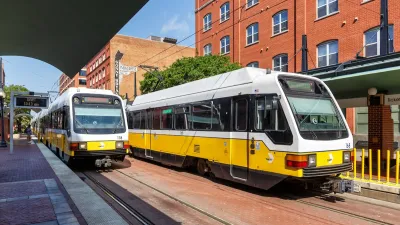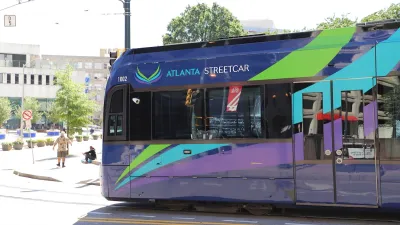A long time ago in a previous design office, I made the mistake of engaging a light rail fanatic in a debate about whether Peachtree Street in Atlanta should be adorned with a light rail line. The debate turned into a protracted email diatribe about the pros and cons of light rail and whether this specific idea made any sense.
A long time ago in a previous design office, I made the mistake of engaging a light rail fanatic in a debate about whether Peachtree Street in Atlanta should be adorned with a light rail line. The debate turned into a protracted email diatribe about the pros and cons of light rail and whether this specific idea made any sense. Imagine my surprise when I learned this week that there is in fact a proposal for a new light rail line along Peachtree Streets.
Don't get me wrong, I have nothing against light rail. In fact, I have been pro light rail on many occasions and see its inherent benefits. Transforming Peachtree Street into a "world class corridor" is a must and I have no doubt that adding streetcars would add an allure to the streetscape it currently lacks.
But Peachtree Street has rail in many locations. Granted it's underground and underutilized, but this infrastructure remains a potential asset that could be creatively imprinted on the street surface. The article does not even mention MARTA's existing line.
More importantly, I would hope that any transit investment on this magnitude would pick up on one of the City's most unique assets - its adjacent neighborhoods. As someone who used to live in one of these areas, I remember vividly that what I truly wanted was an option, on occasion, to not drive in Atlanta. Wouldn't light rail be better suited to connect these neighborhoods to Peachtree Street? (The proposed Beltine in Atlanta holds a lot of promise in this regard) It will be interesting to see the study's final report due out in March.

Alabama: Trump Terminates Settlements for Black Communities Harmed By Raw Sewage
Trump deemed the landmark civil rights agreement “illegal DEI and environmental justice policy.”

Planetizen Federal Action Tracker
A weekly monitor of how Trump’s orders and actions are impacting planners and planning in America.

The 120 Year Old Tiny Home Villages That Sheltered San Francisco’s Earthquake Refugees
More than a century ago, San Francisco mobilized to house thousands of residents displaced by the 1906 earthquake. Could their strategy offer a model for the present?

In Both Crashes and Crime, Public Transportation is Far Safer than Driving
Contrary to popular assumptions, public transportation has far lower crash and crime rates than automobile travel. For safer communities, improve and encourage transit travel.

Report: Zoning Reforms Should Complement Nashville’s Ambitious Transit Plan
Without reform, restrictive zoning codes will limit the impact of the city’s planned transit expansion and could exclude some of the residents who depend on transit the most.

Judge Orders Release of Frozen IRA, IIJA Funding
The decision is a victory for environmental groups who charged that freezing funds for critical infrastructure and disaster response programs caused “real and irreparable harm” to communities.
Urban Design for Planners 1: Software Tools
This six-course series explores essential urban design concepts using open source software and equips planners with the tools they need to participate fully in the urban design process.
Planning for Universal Design
Learn the tools for implementing Universal Design in planning regulations.
Clanton & Associates, Inc.
Jessamine County Fiscal Court
Institute for Housing and Urban Development Studies (IHS)
City of Grandview
Harvard GSD Executive Education
Toledo-Lucas County Plan Commissions
Salt Lake City
NYU Wagner Graduate School of Public Service






























